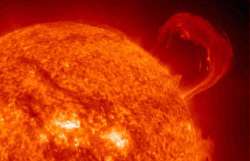Why is the Sun's atmosphere much hotter than its surface
The corona is hundreds to thousands of times hotter than the Sun's visible surface, the photosphere.

Scientists have found that small solar flare could help explain why the Sun's atmosphere, the corona, is so much hotter than the surface.
The corona is hundreds to thousands of times hotter than the Sun's visible surface, the photosphere.
Because the Sun produces heat at its core, this runs counter to what one would initially expect: normally the layer closest to a source of heat, the Sun's surface, in this case, would have a higher temperature than the more distant atmosphere.
"If you've got a stove and you take your hand farther away, you don't expect to feel hotter than when you were close," said one of the study authors Lindsay Glesener from University of Minnesota in the US.
The cause of these counterintuitively high temperatures is an outstanding question in solar physics.
One possible solution to the coronal heating problem is the constant eruption of tiny solar flares in the solar atmosphere, so small that they can not be directly detected.
In a study published in the journal Nature Astronomy this week, the scientists reported that a NASA sounding rocket instrument spotted signatures of the long-sought small solar flares.
The second flight of the FOXSI instrument - short for Focusing Optics X-ray Solar Imager - during its December 2014 flight on a suborbital sounding rocket detected a type of light called hard X-rays - whose wavelengths are much shorter than the light humans can see - which is a signature of extremely hot solar material.
These kinds of temperatures are generally produced in solar flares, powerful bursts of energy.
But in this case, there was no observable solar flare, meaning the hot material was most likely produced by a series of solar flares so small that they were undetectable from Earth: nanoflares.
"The key to this result is the sensitivity in hard X-ray measurements," said Shin-nosuke Ishikawa, a solar physicist at the Japan Aerospace Exploration Agency, or JAXA, and lead author on the study.
"Past hard X-ray instruments could not detect quiet active regions, and combination of new technologies enables us to investigate quiet active regions by hard X-rays for the first time," Ishikawa added.
FOXSI is a collaboration between the US and e Japan Aerospace Exploration Agency.